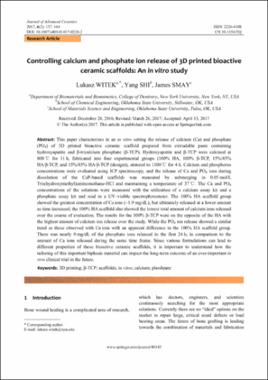| dc.contributor.author | Witek, L. | |
| dc.contributor.author | Shi, Yang | |
| dc.contributor.author | Smay, James Earl | |
| dc.date.accessioned | 2019-09-25T18:24:43Z | |
| dc.date.available | 2019-09-25T18:24:43Z | |
| dc.date.issued | 2017 | |
| dc.identifier | oksd_witek_controllingcalc_2017-06-01 | |
| dc.identifier.citation | Witek, L., Shi, Y., & Smay, J. E. (2017). Controlling calcium and phosphate ion release of 3D printed bioactive ceramic scaffolds: An in vitro study. Journal of Advanced Ceramics, 6(2), 157-164. https://doi.org/10.1007/s40145-017-0228-2 | |
| dc.identifier.uri | https://hdl.handle.net/11244/321442 | |
| dc.description.abstract | his paper characterizes in an in vitro setting the release of calcium (Ca) and phosphate (PO4) of 3D printed bioactive ceramic scaffold prepared from extrudable paste containing hydroxyapatite and β-tricalcium phosphate (β-TCP). Hydroxyapatite and β-TCP were calcined at 800 °C for 11 h, fabricated into four experimental groups (100% HA, 100% β-TCP, 15%/85% HA/β-TCP, and 15%/85% HA/β-TCP (design)), sintered to 1100 °C for 4 h. Calcium and phosphorus concentrations were evaluated using ICP spectroscopy, and the release of Ca and PO4 ions during dissolution of the CaP-based scaffolds was measured by submerging in 0.05 mol/L Tris(hydroxymethyl)aminomethane-HCl and maintaining a temperature of 37 °C. The Ca and PO4 concentrations of the solutions were measured with the utilization of a calcium assay kit and a phosphate assay kit and read in a UV–visible spectrophotometer. The 100% HA scaffold group showed the greatest concentration of Ca ions (~1.9 mg/dL), but ultimately released at a lower amount as time increased; the 100% HA scaffold also showed the lowest total amount of calcium ions released over the course of evaluation. The results for the 100% β-TCP were on the opposite of the HA with the highest amount of calcium ion release over the study. While the PO4 ion release showed a similar trend as those observed with Ca ions with an apparent difference in the 100% HA scaffold group. There was nearly 0 mg/dL of the phosphate ions released in the first 24 h, in comparison to the amount of Ca ions released during the same time frame. Since various formulations can lead to different properties of these bioactive ceramic scaffolds, it is important to understand how the tailoring of this important biphasic material can impact the long-term outcome of an ever-important in vivo clinical trial in the future. | |
| dc.format | application/pdf | |
| dc.language | en_US | |
| dc.publisher | SpringerOpen | |
| dc.rights | This material has been previously published. In the Oklahoma State University Library's institutional repository this version is made available through the open access principles and the terms of agreement/consent between the author(s) and the publisher. The permission policy on the use, reproduction or distribution of the material falls under fair use for educational, scholarship, and research purposes. Contact Digital Resources and Discovery Services at lib-dls@okstate.edu or 405-744-9161 for further information. | |
| dc.title | Controlling calcium and phosphate ion release of 3D printed bioactive ceramic scaffolds: An in vitro study | |
| osu.filename | oksd_witek_controllingcalc_2017-06-01.pdf | |
| dc.description.peerreview | Peer reviewed | |
| dc.identifier.doi | 10.1007/s40145-017-0228-2 | |
| dc.description.department | Chemical Engineering | |
| dc.type.genre | Article | |
| dc.type.material | Text | |
| dc.subject.keywords | 3d printing | |
| dc.subject.keywords | ?-tcp | |
| dc.subject.keywords | scaffolds | |
| dc.subject.keywords | calcium | |
| dc.subject.keywords | phoshpate | |
| dc.subject.keywords | in vitro | |
